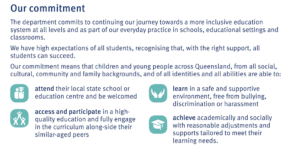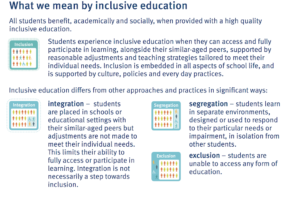By Catia Malaquias
The Queensland Government has released its new Inclusive Education Policy for Queensland’s public schools (Queensland Policy).
Importantly, the Queensland Policy is based upon the leading and most authoritative international instrument on inclusive education (General Comment No. 4: The Right to Inclusive Education) which clarifies the obligations of State parties (including Australia) in relation to inclusive education under the United Nations Convention on the Rights of Persons with Disabilities (CRPD), and particularly Article 24 (Education) of that Convention.
Consistent with General Comment No. 4 which calls for the transformation of education systems to inclusive education, the purpose of the Queensland Policy is stated to be to document the Queensland Education Department’s “commit[ment] to continue to work towards a more inclusive state education system” and “the principles, which will guide that work”:
“Our commitment means that children and young people across Queensland, from all social, cultural, community and family backgrounds, and of all identities and all abilities can:
- attend their local state school and [early] education centre and be welcomed
- access and participate in a high-quality education and fully engage in the curriculum alongside their similar-age peers
- learn in a safe and supportive environment, free from bullying, discrimination or harassment
- achieve academically and socially with reasonable adjustments and supports tailored to meet their learning needs.”
 The Queensland Policy states that the Department’s work towards a more inclusive state education system “will be guided by nine principles adapted from the United Nations’ nine core features for inclusive education” as set out in General Comment No.4.
The Queensland Policy states that the Department’s work towards a more inclusive state education system “will be guided by nine principles adapted from the United Nations’ nine core features for inclusive education” as set out in General Comment No.4.
Critically, the Queensland Policy defines “inclusive education” consistently with General Comment No.4 and by contrasting it against education practices that the General Comment specifically states are not “inclusive education”, but frequently and wrongly are contended to be. The Queensland Policy states:
“Inclusive education means that students can access and fully participate in learning, along-side their similar age peers, supported by reasonable adjustments and teaching strategies tailored to meet their individual needs. Inclusion is embedded in all aspects of school life, and is supported by culture, policies and every day practices.
Inclusive education differs from the following approaches and practices in significant ways:
- Integration– students are placed in schools or educational settings with their similar-aged peers but adjustments are not made to meet their individual needs. This limits their ability to fully access or participate in learning. Integration is not necessarily a step towards inclusion.
- Segregation– students learn in separate environments, designed or used to respond to their particular needs or impairment, in isolation from other students.
- Exclusion– students are unable to access any form of education.”
It is an important and transformative signal for the Queensland Policy to recognise that “placing” students with disability without adequate supports and curricula adjustments in regular classrooms is not “inclusive education” but “integration” – i.e. conditional access on the basis of the student adjusting to the classroom rather than the other way round.
Even more significant is the acknowledgement that separate “special schools” and separate “special units” and “special classrooms” in mainstream schools are not “inclusive education” but the opposite, exercises in the “segregation” of students with disability.
However, whilst committing to advancing inclusive education, the Queensland Policy includes the following sentence:
“The department will continue to offer parents the choice of enrolling their child, who meets set criteria[,] in highly individualised programs, including through special schools and academies.”
It is not clear whether, in the context of students with disability, this sentence is to be read as pragmatic given that the transformation to an inclusive education system will take some time or whether segregated education options are to some extent proposed to be preserved. It is hoped that it will be the former and that the Department’s more detailed strategy for transitioning to and implementing an inclusive education system will phase out “segregation” of students with disability.
In this regard, General Comment No.4 makes it clear that while the obligation of Governments to provide “reasonable accommodation” for a student with disability is an immediate obligation, the transformation of education systems is on the basis of “progressive realisation” and “non-regression”. This requires Governments to take take deliberate steps immediately and in the future towards the full realisation of of inclusive education systems, but also recognises that full realisation involves a process of transition and transformation. Paragraph 39 of General Comment No. 4 states as follows:
“Progressive realization means that State parties have a specific and continuing obligation “to move as expeditiously and effectively as possible” towards the full realization of article 24. This is not compatible with sustaining two systems of education: mainstream and special/segregated education systems. Progressive realization must be read according to the overall objective of the Convention to establish clear obligations for States parties in respect of the full realization of the rights in question.”
Further, paragraph 68 of General Comment No.4 urges “the transfer of resources from segregated to inclusive environments” and the development of “a funding model that allocates resources and incentives for inclusive educational environments to provide the necessary support to persons with disabilities.”
The Queensland Government may be guided by some excellent examples of systemic transformation in its own State schools, such as Thuringowa State High School in Queensland which closed its “special” unit in 2015 in favour of implementing quality inclusive practice across the school. It is worth noting that when the decision to do this was announced, fearful parents of students in the unit took to social media to set up protest pages, criticised the school in the mainstream media and appealed to their Education Minister. These same parents are now firm supporters of the new model, having seen the transformative impact of genuine school inclusion on their children and others.
The Queensland Policy links to a 2013 “Minister’s Policy – Criteria to decide a person is a ‘person with a disability’ for the purpose of enrolment in state special schools”. That policy speaks of the “decision-maker” having an “absolute discretion” to determine whether the student meets the enrolment criteria which include:
- “The person is unlikely to attain the levels of development of which the person is capable unless the person receives special education
- The person’s educational program is best delivered in a special school taking into account the appropriateness of this placement for the individual concerned.”
In light of the more recent General Comment No. 4 (released in 2016) upon which the new Queensland Policy is based, and the extensive and consistent research evidence showing that students with disability benefit more academically and socially when educated together with their non-disabled peers (see “A Summary of the Evidence on Inclusive Education“ a 2016 comprehensive review of international research), it is essential that the criteria for ‘special school’ enrolment also be reviewed as part of the departmental strategy for transitioning to and implementing a State-wide inclusive education system.
_______
Starting With Julius commends the Queensland Government for being the first State in Australia to incorporate the authoritative guidance of the UN Committee on the Rights of Persons with Disabilities, developed with the very significant input of the world-wide disability community, inclusive education and human rights experts and State Parties, into its education policy for all students, including students with disability. As stated in the UNESCO Global Education Monitoring Report released only days after the new Queensland Policy:
“A rights-based approach has broken new ground in inclusive education and offers a basis for accountability mechanisms. Governments can ensure inclusiveness in the right to education for persons with disabilities by fulfilling CRPD commitments to establish mechanisms for coordination, independent monitoring, enforcement, complaint and reparation.”
We look forward to Queensland further developing its implementation strategy for transforming its public education system in accordance with its new Inclusive Education Policy, in addition to recent initiatives such as establishing the Disability and Inclusion Branch and the Autism Hub and Reading Centre, employing inclusion coaches and investing in a program of inclusive education Masters scholarships for school Principals and training and resource development across the board.
We also hope that the Queensland Policy will provide a template for other States and Territories to revisit and reformulate their own policies and approaches to inclusive education.
You can read more about the Queensland Policy and related documents on the Department of Education’s website.
[Cover photo © Queensland Government]
Thank you for visiting our website. You can also keep up with our mission for #edinclusion by liking our Facebook page or following us on Twitter @StartingWJulius

